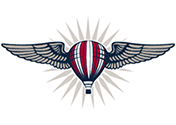| Resources for Teachers |
Balloon Related ProjectsWe have compiled a teachers manual in PDF format. Manual – part 1 We have collected a variety of projects that illustrate concepts relevant to hot-air ballooning. Got any good ideas we haven’t heard? Send them to us and we’ll post them (and give you credit here on our site!) Research Project Research ProjectUsing the resource list, contact all of the manufacturers and the BFA. Collect information from these sources and the library regarding hot-air balloons. Draw up a price comparison list. What balloon make do you think you would ultimately buy? Why? Consider costs, design features, popularity, safety. Detail other factors that influence your decision. What would your balloon look like? Would you like to pursue a career as a hot-air balloon pilot? Would you compete and/or sell rides, or seek out a commercial contract? How would you decide this? Why would you pilot balloons instead of airplanes, helicoptors or gliders? Maybe you would earn several ratings so you could fly these other aircraft also! Maybe you would decide to crew for a pilot instead of actually learning to fly? Contact a local hot-air balloon pilot and interview him/her about the above questions. How did he or she make their decisions? (top) Discussion QuestionsWhat makes a hot-air balloon float? What makes a helium balloon float? When was the first hot-air balloon built? How high can balloons go? How do you steer a hot air balloon? Are hot-air balloons safe? What weather conditions are best for hot-air balloon flight? Where are the best places to fly hot-air balloons? How far does a balloon fly? How much does a balloon cost? A balloon flight can be a beautiful adventure. But why can’t balloons be used for daily transportation? Air Pressure ExperimentExplore Low and High pressure air masses Relatively speaking, air which is moving exerts low pressure, and air that is still exerts high pressure. This was discovered in the late 1700’s by a scientist named Daniel Bernoulli. And it is because of this discovery that we can make wings that create lift and make an airplane fly. As the wing slices through the air, the air molecules moving over the top of the wing must make it to the other side at the same time as the molecules under the wing. Because the wind is curved on top, those molecules have further to go and must move faster. The combination of low pressure on top and high pressure below work together to create an upward push called “lift”. Try this experiment to illustrate this concept: Materials List:
Tie the strings one to each balloon. Hang or hold the balloons about 1 inch apart. Have another student blow gently between the two balloons. The balloons will be “pushed” together. Remember the pressure will be lower between the two balloons while you are blowing air through (because moving air has less pressure) The pressure on the sides of the balloons is higher, because that air is moving. What happens when:
Think about how this concept applies to weather systems. Would you think that an area of low pressure in a weather report would tend to be more windy or more calm? What about an approaching high pressure system?(top) Weather Vane ProjectHot air balloon pilots do not have a steering wheel or any other mechanical means of steering their balloons. Sometimes, though, the wind at several thousand feet above the ground (winds aloft) will be going a different direction than that which is blowing over the surface. With these changes of direction, the pilot is able to do some “navigation” by controlling to some extent where the balloon will fly and where it will land. Pilots always get a weather and winds forecast before every flight so that they will have an indication of the direction and speed the balloon will travel once launched. Remember though, it’s mostly up to Mother Nature! One way of determining which way the wind is blowing is to build a weather vane. Materials List:
Extension: Chart the winds observed outside your window for a week. Use the Beaufort (developed 1806) Wind Scale:
When is it typically the windiest during the day? Paper Mache Hot-Air Balloons ProjectMaterials List:
Instructions Allow the balloon to dry, then paint designs Paste construction or contact paper on the sides of the milk carton base Tie the gondola (milk carton) on with 4 pieces of string after punching small holes (use holepunch) in the mouth of the balloon and sides of carton Hang up for display! (top) Ballooning Song(sing to the tune of Skip to My Lou) Rise, Rise, Lighter than Air! Float, Float, Float Through the Sky! Light the Burner, Let’s go Higher! Pull the Ripcord Ready to Land! Word GameThe words listed below should be considered in an aeronautical context, and the definitions as well. Wacky Words
Scoring: Word List:
Creative Writing ExerciseCompose a shrt story about an imaginary balloon trip you take. Base it on one or two concepts you have learned about with respect to hot-air balloons (weather, licensing, history, navigation, terrain, rallies, competition, laws, etc). If you need to, research more information about your chosen concepts at the library (or use the resource list) to give your story depth and focus. (top) Pick a product that you would like to see represented by a balloon. What type of balloon would you select? Design the balloon shape (remember, some pilot has to fly the thing!) Maybe make up an appropriate slogan, and list the places where you want to have this balloon fly, and explain why you chose these places. What people (market) would you want to reach? (top) |

